Randle cycle - can you mix carbs and fats safely?
Who needs to care, protocols and proper testing guidelines.
P.S. Leave a comment if you’re unclear about anything here. I can even set up an AMA on this topic if there’s enough interest.
What if I told you separating carbs and fats is just a patch, not a cure?
Most people with insulin resistance, high cholesterol, triglycerides, or metabolic syndrome believe glucose itself is the enemy. They cut carbs drastically, thinking glucose is "toxic." Some are terrified to eat more than 50g of carbs per day, especially fructose.
But here's the truth: It's not glucose that's the problem. It's the body's impaired ability to metabolize it correctly.
In this article, we'll cover:
How glucose and fats are metabolized in the body
The full details of the Randle Cycle
Why dysfunction in this cycle leads to metabolic disease
The real reasons for insulin resistance
Why fixing metabolism requires rebuilding mitochondrial health and nutrient sufficiency
Practical strategies to fix the root causes
Let's start from the top.
1. How Carbohydrates Are Normally Metabolized
From Mouth to Storage
Dietary glucose enters the bloodstream after digestion and absorption in the small intestine.
It is primarily taken up by muscle tissue and stored as glycogen or oxidized to produce ATP and CO2.
Excess glucose goes to the liver, where it’s stored as liver glycogen.
If liver glycogen is full, glucose oxidation increases to "burn off" the excess.
If you eat 500g of carbs a day, the body burns 500g of carbs a day.
Only 1–5% of large carb loads (≥500g/day) are converted to fat via de novo lipogenesis (DNL). It’s an energy-demanding process. Diabetics have elevated DNL of 10-15%, but that’s still low.
Fructose
Fructose is partially converted to glucose in the intestine.
The remainder is shuttled to the liver to replenish liver glycogen (even better than glucose).
Fructose is absorbed more slowly than glucose, moderating blood sugar responses.
Fructose can actually improve glucose uptake and lower blood sugar spikes during meals.
Study: Eating an apple before rice halved the glycemic response. Fructose has an insulinogenic effect and enhances glucose uptake into cells without the need for insulin.
Cellular Entry
Glucose enters cells via GLUT1 (insulin-independent) and GLUT4 (insulin-dependent) transporters.
Fructose enters via GLUT2 and GLUT5 (insulin-independent).
In insulin resistance, GLUT4 is impaired, but hyperglycemia is mainly due to excess lipolysis (release of fat from fat stores) and gluconeogenesis (production of glucose), driven by cortisol, adrenaline, and glucagon.
Furthermore, I discuss:
Glycogen storage and glycolysis
Randle cycle and the hormones that control glucose and fat oxidation
Electron transport chain
Nuances and important notes
Carb partitioning during the day
Importance of meal timing and spacing
Practical strategies to fix the underlying problem
Tests to do
Conclusion




